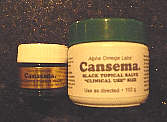|
Alpha Omega Labs:
Commentary on "In Situ" versus
Systemic Conditions in Connection
with Escharotic Use

 We are frequently asked about the use of
Cansema (Amazon) Black Topical Salve,
when the evidence of malignancy is widespread.
 For example, someone may write to us
and indicate that they have successfully treated 10, 15, or even 50
skin cancers over a period of a couple years, using
Cansema. They will then ask
what is the best approach in eliminating a large number of malignancies
over a wider area of the body.
 First and foremost, it is important
to understand that topical escharotics are primarily designed to remove
skin cancers "in situ" --- that is, the malignancy is localized and is not
indicative of widespread or "systemic" cancer activity. When the growths
in question are numerous and can be found on various places over the
skin (the single largest organ of the body), this is normally not an indication
of localized malignancy. These growths arise as a result of carcinogenesis
that is widespread.
 Systemic problems require systemic solutions,
so below we list some of our recommendations for those cases where it is obvious
that the growths in question are clearly not "localized." These techniques
create an internal "environment" within the body that is hostile to cancer
growth and each of them have a long history of effective application and
results.

- pH Adjustment Therapy -- Some of the more popular methods of
"alkalizing" the body include the Kelmun
protocol and various Cesium Chloride
protocols. We have used both of these in our work; however, we find the use of solutions that
provide heavy "oxygen donors" (H-) to the user to be more effective. To this end we recommend
using HRx to raise the body's overall pH.
- Bio-oxidative Therapy -- There are effective therapies that employ hydrogen peroxide 35%,
both internally and externally. The peroxide can be
obtained locally by the customer and the foregoing link provides the instructions.
- Internal, Natural 'Chemotherapeutic' Agents -- A diet that consists of anti-cancer
foods, like broccoli, asparagus, turmeric, raspberries, tomatoes, and medicinal mushrooms
(i.e. turkey tail, reishi, maiitake, etc.) helps. We have a page full of
recommended anti-cancer dietary books.
 However, in addition to this, anti-cancer herbs and
specialized formulas can make a big difference. To this end, we produce
Cansema (Amazon) Tonic III, our primary
"internal escharotic," Cansema Bloodroot Capsules,
and a variety of anti-cancer teas, which include
Cat's Claw,
Chanca Piedra,
Chaparral,
Graviola,
and Ajo Te. However, in addition to this, anti-cancer herbs and
specialized formulas can make a big difference. To this end, we produce
Cansema (Amazon) Tonic III, our primary
"internal escharotic," Cansema Bloodroot Capsules,
and a variety of anti-cancer teas, which include
Cat's Claw,
Chanca Piedra,
Chaparral,
Graviola,
and Ajo Te.
- Rooting Out Inputs -- It doesn't do any good to take anti-cancer measures while
sustaining lifestyle practices and subjecting yourself to environmental conditions that feed
cancer growth. Among the chief inputs that people need to avoid are:
- GMO Foods -- Most processed foods in the West contain a variety of ingredients
that are derived from corn, soybean, rice, wheat and other agricultural commodities, of
which the majority are now "genetically modified." It is beyond this short treatise to
expound on the dangers of GMO foods; however, if you are unfamiliar with this subject,
we strongly suggest that you research it.
There are not only considerable
environmental hazards to GMO,
but by consuming GMO foods, you're only
feeding your cancer(s).
- Examine the electromagnetic pollution you allow yourself
to be subjected to. [We recommend reading Dr. Milham's
Dirty Electricity:
Electrification and the Diseases of Civilization.
- Don't smoke . . . and :
- Access your Emotional Contributors to Cancinogenesis. (Study the work of
Ryke Hamer.
- Examine the Contributions of Faulty Dentistry.
There is a correlation in a high percentage of overall cancer cases (especially breast cancer)
between faulty dental work, particularly root canals, and systemic cancers. We highly recommend
the removal of root canals.
 These are the chief inputs that can work against the rest of
your program to address systemic cancer issues.
 Cathryn Caton, N.D.
Cathryn Caton, N.D.
Alpha Omega Labs
Guayaquil, Ecuador
January 12, 2016
|



